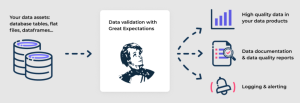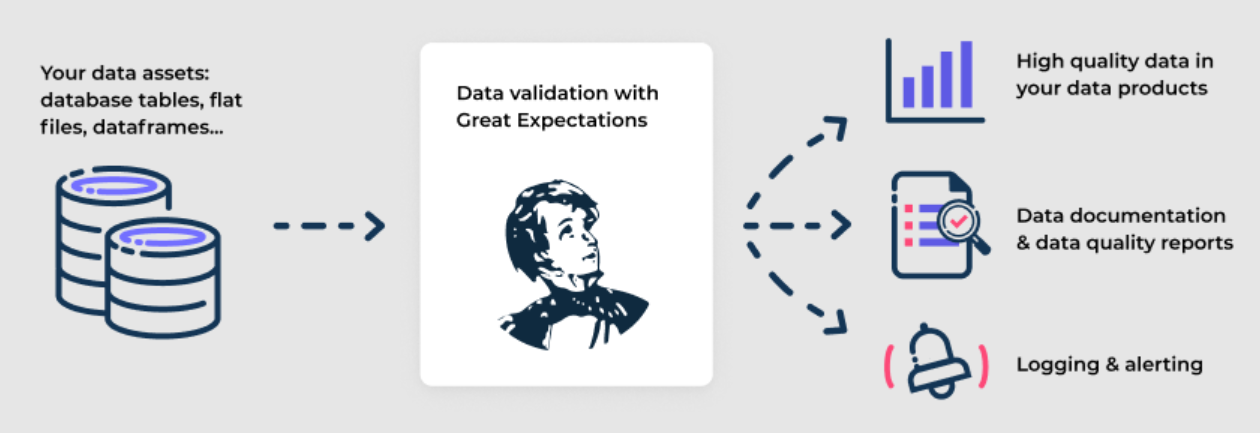
Testing the data that is being processed from Extract, Transform and Load (ETL) processes is a critical step in ensuring the accuracy of data contained in destination systems and databases. This blog post will provide an overview of ETL & Data Quality testing including tools, test cases and examples.
What is ETL?
ETL stands for extract, transform, and load. ETL is a three-step process that is used to collect data from various sources, prepare the data for analysis, and then load it into a target database. The extract phase involves extracting data from its original source, such as a database or file system. The transform phase involves transforming this data into a format that can be used by the target system or database. Finally, the load phase involves loading this transformed data into its destination system or database.
ETL can be used to perform simple tasks such as data cleansing and validation, or more complex tasks such as data warehousing and data mining. ETL is often used in conjunction with business intelligence (BI) tools to generate reports and dashboards. ETL is commonly used in scenarios where data needs to be moved from one system to another (for example, from an on-premises database to the cloud), or where multiple data sources need to be combined into a single dataset. Some of the most popular ETL tools on the market include Informatica PowerCenter, Talend Data Services, and IBM DataStage.
Data Quality Test Cases & ETL
Data quality test cases help to ensure that the data being extracted, transformed and loaded is accurate and complete. These tests are designed to identify any potential issues with the data before it gets loaded into its destination system or database. Some examples of these test cases include:
- Ensuring that there are no null values
- Ensuring that minimum volume of data is obtained
- Verifying the data distribution in the sense that all values are within the expected range
- Ensuring all required fields are included in the transformation process
- Checking for missing values
- Testing for invalid characters
- Data integrity: Data integrity test checks for consistency and accuracy between different sets of records both within the same database and across multiple databases if applicable. This might involve looking for duplicate records or identifying areas where relationships between different fields should exist but do not due to missing information or incorrect entries elsewhere in the database structure. Integrity tests can also help identify errors caused by incomplete extracts from source systems which can lead to inaccurate results when loading into target warehouses down the line if they are not corrected before-hand.
- Data validation: This type of test will check whether or not each field of data contains valid information according to its specified format. It will also look at content relationships within fields and across different fields to make sure that they are consistent with one another as well as being valid within each individual field. For example, if a date field has an invalid date format then this would be flagged by this type of test, as would inconsistencies between different fields such as having a customer name listed in one field but no corresponding address listed in another field.
- Data completeness: This test will check to make sure that all necessary records have been extracted from the source systems and loaded into the target data storage systems correctly.
These tests should be run on both the source and target systems to ensure accuracy throughout the entire ETL process.
The following is recommended to be done when running data quality tests:
- The transformed data should be loaded into a temporary staging database.
- One or more unit tests should be run to ensure that the data in the staging database meet the criteria of all the data quality unit tests
Data Quality Unit Testing Framework
Data quality unit testing frameworks provide organizations with the ability to validate and ensure that their data is accurate and reliable. One of the most well-known frameworks is called dbt (data build tooling). This open source platform automates the process of writing, running, and monitoring tests on incoming data sources in order to identify any discrepancies or errors. It includes a library of standard tests such as data type validation and column check which can be customized to meet specific business requirements. Additionally, dbt provides the ability to reliably track the provenance of data sets through version control and time-stamped datasets.
Another popular platform for data quality testing is called Great Expectations which can be applied to various ETL / ELT solutions. It an open source tool, that provides technique such as “assert what you expect” from the data in the form of unit tests. The unit tests are written in Python and this makes it more extensible than dbt testing. It uses an automated system of checks to assess incoming data streams and detect any anomalies or potential problems with its accuracy or reliability. Similar to dbt, it supports custom tests as well as a library of standard tests. The platform also supports multiple data sources from streaming APIs, databases, CSV files, etc., making it a powerful tool for detecting issues with incoming data sets across different formats. Furthermore, Great Expectations has built-in visualizations for easy analysis of test results which allows users to quickly identify potential issues in their datasets. Here is a sample unit test code to validate whether the zip_code consists of valid zip code:
expect_column_values_to_be_between(
column="zip_code",
min_value=1,
max_value=99999
)
Here is the functional architecture representing the data validation using great expectation tool:

Conclusion
By performing thorough Data Quality test cases during ETL process, you can rest assured that your end-user systems will contain accurate data that meets their needs. Although testing can be time consuming and tedious, it’s an essential part of ensuring your business runs smoothly and efficiently. With clear understanding of what data quality test cases looks like, you can craft effective test plans to ensure your users have access to reliable information they need when they need it most!
- Coefficient of Variation in Regression Modelling: Example - November 9, 2025
- Chunking Strategies for RAG with Examples - November 2, 2025
- RAG Pipeline: 6 Steps for Creating Naive RAG App - November 1, 2025
I found it very helpful. However the differences are not too understandable for me